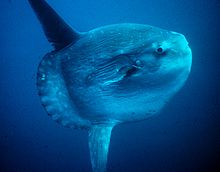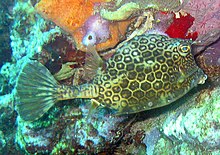| Tetraodontiformes Temporal range: Santonian–recent PreꞒ Ꞓ O S D C P T J K Pg N Possible Cenomanian record | |
|---|---|

| |
| Representatives of the 10 extant Tetraodontiformes families: a Triacanthodidae, Triacanthodes anomalus; b Triacanthidae, Triacanthus biaculeatus; c Balistidae, Abalistes filamentosus; d Monacanthidae, Thamnaconus hypargyreus; e Aracanidae, Kentrocapros aculeatus; f Ostraciidae, Ostracion immaculatus; g Triodontidae Triodon macropterus; h Tetraodontidae, Arothron mappa; i Diodontidae, Diodon liturosus; j Molidae, Masturus lanceolatus | |
| Scientific classification | |
| Domain: | Eukaryota |
| Kingdom: | Animalia |
| Phylum: | Chordata |
| Class: | Actinopterygii |
| Clade: | Percomorpha |
| Order: | Tetraodontiformes L. S. Berg, 1940 |
| Type species | |
| Tetraodon lineatus Linnaeus, 1758 | |
| Suborders and Families | |
|
See text. | |
Tetraodontiformes (/tɛtrə.ɒˈdɒntɪfɔːrmiːz/), also known as the Plectognathi, is an order of ray-finned fishes which includes the pufferfishes and related taxa. This order has been classified as a suborder of the order Perciformes, although recent studies have found that it, as the Tetraodontoidei, is a sister taxon to the anglerfish order Lophiiformes, called Lophiodei, and have placed both taxa within the Acanthuriformes. The Tetraodontiformes are represented by 10 extant families and at around 430 species overall. The majority of the species within this order are marine but a few may be found in freshwater. They are found throughout the world.
Taxonomy
Tetraodontiformes is a name first used for this order in 1940 by Lev Berg, the order was originally proposed in 1817 as the "Les Plectognathes", the Plectognathi. Cuvier divided this into two families "Les Gymnodontes" and "Les Sclerodermes". In 1940 Berg first used the term Tetraodontiformes for this order and this name is the currently accepted name as it follows the International Code of Zoological Nomenclature rule that a name for a family or higher taxa must have its root based on the type species of that grouping. In this case the type species is Tetraodon lineatus Linnaeus, 1758. The 5th edition of Fishes of the World recognises the order as a derived order within the Actinopterygii and as a monophyletic order within the Percomorpha. Other authorities have proposed that it is not an order but that it is a clade, the Tetraodontoidei, within the order Acanthuriformes and is most closely related to the Lophiodei, the anglerfishes.
Etymology
Tetraodontiformes suffixes -iformes, meaning "in the form of", onto the genus name, Tetraodon, of the type species of Tetraodontidae, the best known and most widely distributed family in the order. Tetraodon means "four tooth" and alludes to the four fused teeth, separated by a central suture, in the jaws.
Evolution
The oldest tetraodontiforms are the extinct suborder Plectocretacicoidei from the Late Cretaceous (Santonian to Campanian) of Italy and Slovenia, both in the former Tethyan region. These comprise the families Cretatriacanthidae and Protriacanthidae. Plectocretacicus from the Cenomanian of Lebanon has also been proposed as a tetraodontiform, but this has been more recently questioned.
Description
Tetraodontiformes include a variety of body shapes, all radical departures from the streamlined body plan typical of most fishes. These forms range from nearly square or triangular (boxfishes), globose (pufferfishes) to laterally compressed (filefishes and triggerfishes). They range in size from Rudarius excelsus (a filefish), measuring just 2 cm (0.79 in) in length, to the ocean sunfish, the largest of all bony fishes at up to 3 m (9.8 ft) in length and weighing over 2 tonnes.
Most members of this order – except for the family Balistidae – are ostraciiform swimmers, meaning the body is rigid and incapable of lateral flexure. Because of this, they are slow-moving and rely on their pectoral, dorsal, anal, and caudal fins for propulsion rather than body undulation. However, movement is usually quite precise; dorsal and anal fins aid in manoeuvring and stabilizing. In most species, all fins are simple, small, and rounded, except for the pelvic fins which, if present, are fused and buried. Again, in most members, the gill plates are covered over with skin, the only gill opening a small slit above the pectoral fin.
The tetraodontiform strategy seems to be defense at the expense of speed, with all species fortified with scales modified into strong plates or spines – or with tough, leathery skin (the filefishes and ocean sunfish). Another striking defensive attribute found in the pufferfishes and porcupinefishes is the ability to inflate their bodies to greatly increase their normal diameter; this is accomplished by sucking water into a diverticulum of the stomach. Many species of the Tetraodontidae, Triodontidae, and Diodontidae are further protected from predation by tetrodotoxin, a powerful neurotoxin concentrated in the animals' internal organs.

Tetraodontiforms have highly modified skeletons, with no nasal, parietal, infraorbital, or (usually) lower rib bones. The bones of the jaw are modified and fused into a sort of "beak"; visible sutures divide the beaks into "teeth". This is alluded to in their name, derived from the Greek words τετρα- tetra meaning "four" and ὀδούς odous meaning "tooth" and the Latin forma meaning "shape". Counting these teeth-like bones is a way of distinguishing similar families, for example, the Tetraodontidae ("four-toothed"), Triodontidae ("three-toothed"), and Diodontidae ("two-toothed").
Their jaws are aided by powerful muscles, and many species also have pharyngeal teeth to further process prey items, because the Tetraodontiformes prey mostly on hard-shelled invertebrates, such as crustaceans and shellfish.
The Molidae are conspicuous even within this oddball order; they lack swim bladders and spines, and are propelled by their very tall dorsal and anal fins. The caudal peduncle is absent and the caudal fin is reduced to a stiff rudder-like structure. Molids are pelagic rather than reef-associated and feed on soft-bodied invertebrates, especially jellyfish.
Families
The Tetraodontiformes contains the following suborders and families:
- Suborder †Plectocretacicoidei Tyler & Sorbini, 1996
- Family †Cretatriacanthidae Tyler & Sorbini, 1996
- Family †Plectocretacicidae Tyler & Sorbini, 1996
- Family †Protriacanthidae Tyler & Sorbini, 1996
- Suborder Triodontoidei Bleeker, 1859
- Genus †Ctenoplectus Close, Johanson, Tyler, Harrington & Friedman, 2016
- Family Triodontidae Bleeker, 1859
- Suborder Triacanthoidei Tyler, 1968
- Family Triacanthodidae Gill, 1862
- Subfamily Hollardiinae Tyler, 1968
- Subfamily Triacanthodinae Gill, 1862
- Family Triacanthidae Bleeker, 1859
- Family Triacanthodidae Gill, 1862
- Suborder Ostracioidea Rafinesque, 1810
- Family †Spinacanthidae Santini & Tyler, 2003
- Family Aracanidae Hollard, 1860
- Family Ostraciidae Rafinesque, 1810
- Suborder Balistoidei Rafinesque, 1810
- Family †Bolcabalistidae Santini & Tyler, 2003
- Family †Moclaybalistidae Santini & Tyler, 2003
- Family Balistidae Rafinesque, 1810
- Family Monacanthidae Nardo, 1843
- Suborder Tetraodontoidei Berg, 1940
- Genus †Iraniplectus Tyler, Mirzaie & Nazemi, 2006
- Family †Avitoplectidae Bemis, Tyler, Bemis, Kumar, Rana & Smith, 2017
- Family †Balkariidae Bannikov, Tyler, Arcila & Carnevale, 2016
- Family †Eoplectidae Santini & Tyler, 2003
- Family Molidae Bonaparte, 1835
- Family Tetraodontidae Bonaparte, 1831
- Subfamily Tetraodontinae Bonaparte, 1831
- Subfamily Canthigastrinae Bleeker, 1865
- Family Diodontidae Bonaparte, 1835
- Family †Zignoichthyidae Tyler & Sorbini, 1996
† means extinct.



This cladogram of extant Tetraodontiformes is based on Santini et al., 2013.
| Tetraodontiformes |
| ||||||||||||||||||||||||||||||||||||||||||||||||||||||||||||||||||||||||||||||||||||
Timeline of genera

References
- ^ Matsuura, Keiichi; Tyler, J.C. (1998). Paxton, J.R.; Eschmeyer, W.N. (eds.). Encyclopedia of Fishes. San Diego, California, USA: Academic Press. p. 230. ISBN 978-0-12-547665-2.
- James C. Tyler (1980). "Osteology, phylogeny, and higher classification of the fishes of the order Plectognathi (Tetraodontiformes)". NOAA Technical Report NMFS Circular. 434.
- ^ Leo S. Berg (1940). Classification of fishes, both recent and fossil (PDF) (in Russian and English). Ann Arbor Michigan: J. N. Edwards.
- "International Code of Zoological Nomenclature (Online)". International Commission on Zoological Nomenclature.
- Eschmeyer, William N.; Fricke, Ron & van der Laan, Richard (eds.). "Species in the genus Tetraodon". Catalog of Fishes. California Academy of Sciences. Retrieved 27 August 2024.
- ^ Nelson, J.S.; Grande, T.C.; Wilson, M.V.H. (2016). Fishes of the World (5th ed.). Hoboken, NJ: John Wiley & Sons. pp. 518–526. doi:10.1002/9781119174844. ISBN 978-1-118-34233-6. LCCN 2015037522. OCLC 951899884. OL 25909650M.
- Near, Thomas J.; Thacker, Christine E. (2024-04-18). "Phylogenetic Classification of Living and Fossil Ray-Finned Fishes (Actinopterygii)". Bulletin of the Peabody Museum of Natural History. 65 (1). doi:10.3374/014.065.0101. ISSN 0079-032X.
- "-iformes". www.thefreedictionary.com. Retrieved 27 August 2024.
- Christopher Scharpf (21 August 2024). "Order TETRAODONTIFORMES: Families TRIODONTIDAE, TRIACANTHIDAE, TRIACANTHODIDAE, DIODONTIDAE and TETRAODONTIDAE". Christopher Scharpf. Retrieved 27 August 2024.
- Tyler, James C.; Tyler, James C.; Sorbini, Lorenzo; Institution, Smithsonian (1996). New superfamily and three new families of tetraodontiform fishes from the Upper Cretaceous : the earliest and most morphologically primitive plectognaths. Washington, D.C.: Smithsonian Institution Press.
- ^ Froese, Rainer; Pauly, Daniel, eds. (2023). "Order Summary for Tetraodontiformes". FishBase. Retrieved 1 April 2023.
- Ponder, Winston Frank; Lindberg, David R.; Ponder, Juliet Mary (2019). Biology and Evolution of the Mollusca. Vol. 1. Boca Raton, Florida, USA: CRC Press. ISBN 978-1-351-11565-0.
- Richard van der Laan; William N. Eschmeyer & Ronald Fricke (2014). "Family-group names of recent fishes". Zootaxa. 3882 (2): 1–230. doi:10.11646/zootaxa.3882.1.1. PMID 25543675.
- Close, Roger A.; Johanson, Zerina; Tyler, James C.; Harrington, Richard C.; Friedman, Matt (2016). Sigwart, Julia (ed.). "Mosaicism in a new Eocene pufferfish highlights rapid morphological innovation near the origin of crown tetraodontiforms". Palaeontology. 59 (4): 499–514. doi:10.1111/pala.12245. ISSN 0031-0239.
- ^ Franceso Santini; James C. Tyler (2003). "A phylogeny of the families of fossil and extant tetraodontiform fishes (Acanthomorpha, Tetraodontiformes), Upper Cretaceous to Recent". Zoological Journal of the Linnean Society. 139 (4): 565–617. doi:10.1111/j.1096-3642.2003.00088.x.
- Tyler, J.C.; Mirzaie, M.; Nazemi, A. (2006). New genus and species of basal tetraodontoid puffer fish from the Oligocene of Iran, related to the Zignoichthyidae (Tetraodontiformes). Bollettino del Museo Civico di Storia Naturale di Verona Geologia Paleontologia Preistoria, 30, 49–58
- Bemis, Katherine E.; Tyler, James C.; Bemis, William E.; Kumar, Kishor; Rana, Rajendra Singh; Smith, Thierry (2017-11-02). "A gymnodont fish jaw with remarkable molariform teeth from the early Eocene of Gujarat, India (Teleostei, Tetraodontiformes)". Journal of Vertebrate Paleontology. 37 (6): e1369422. doi:10.1080/02724634.2017.1369422. ISSN 0272-4634.
- Bannikov, Alexandre F.; Tyler, James C.; Arcila, Dahiana; Carnevale, Giorgio (2017-02-01). "A new family of gymnodont fish (Tetraodontiformes) from the earliest Eocene of the Peri-Tethys (Kabardino-Balkaria, northern Caucasus, Russia)". Journal of Systematic Palaeontology. 15 (2): 129–146. doi:10.1080/14772019.2016.1149115. ISSN 1477-2019.
- Santini, Francesco; Sorenson, Laurie; Alfaro, Michael E. (2013). "A new phylogeny of tetraodontiform fishes (Tetraodontiformes, Acanthomorpha) based on 22 loci". Molecular Phylogenetics and Evolution. 69 (1): 177–187. doi:10.1016/j.ympev.2013.05.014. PMID 23727595.
- Froese, Rainer; Pauly, Daniel (eds.). "Order Tetraodontiformes". FishBase. January 2006 version.
- Tree of Life: Tetraodontiformes
- Sepkoski, Jack (2002). "A compendium of fossil marine animal genera". Bulletins of American Paleontology. 364: 560. Retrieved 2011-04-21.
| Extant orders of Actinopterygii (ray-finned fish) | |||||||||||||||||||||||||||||||||||||||||||||||
|---|---|---|---|---|---|---|---|---|---|---|---|---|---|---|---|---|---|---|---|---|---|---|---|---|---|---|---|---|---|---|---|---|---|---|---|---|---|---|---|---|---|---|---|---|---|---|---|
| |||||||||||||||||||||||||||||||||||||||||||||||
| |||||||||||||||||||||||||||||||||||||||||||||||

